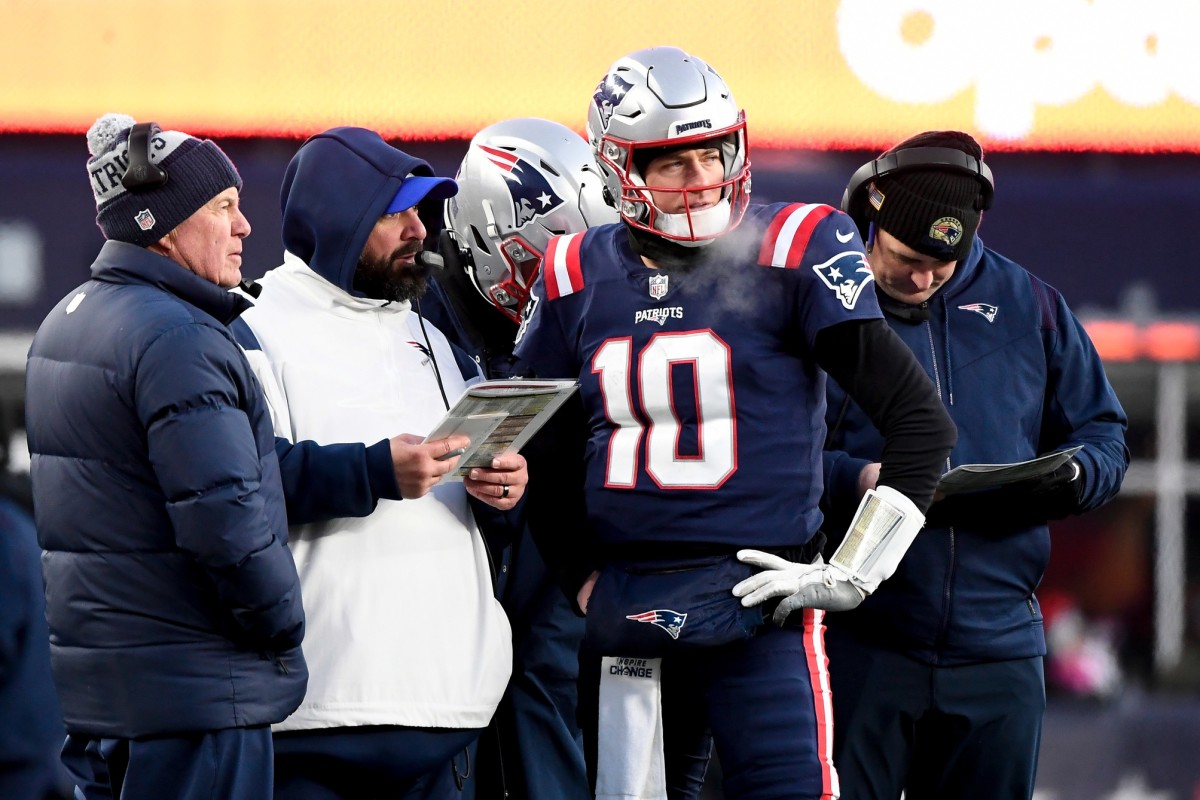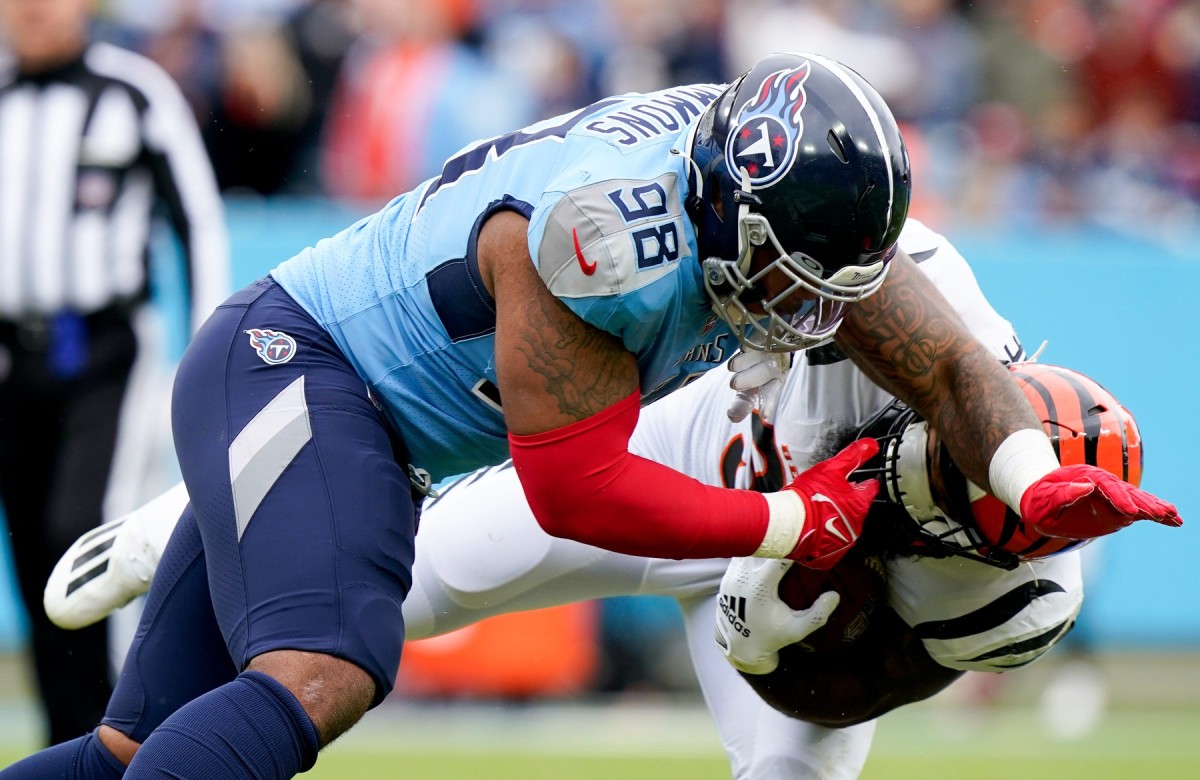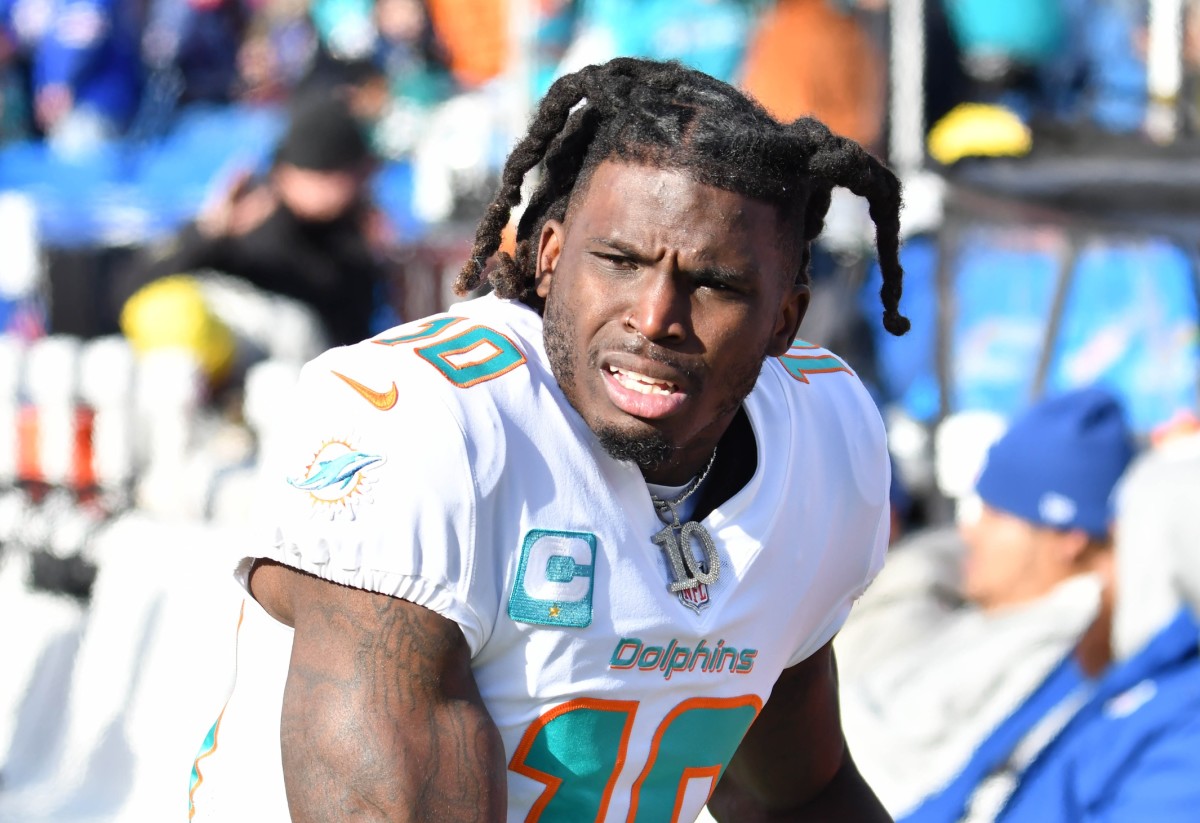Bill O’Brien Navigating a Challenging Situation With Mac Jones and Bill Belichick

More from Albert Breer: Inside Shane Steichen’s Plans to Build a Winning Culture With the Colts | NFL Draft 2023: Breaking Down How the Top Seven Picks Could Play Out | Odell Beckham Jr. Going to the Ravens Doesn’t Mean There’s a Solution With Lamar Jackson | The NFL Must Look Into the Details in the Allegations Against Cardinals Owner Michael Bidwill
Offseason programs are underway, and we’re rolling toward the draft, so let’s get to a few takeaways from this past week …
There’s a lot on Bill O’Brien in Foxborough in his return to the NFL. Yes, he’s coming back as an offensive coordinator, and not a head coach. Sure, he’s working for the greatest head coach of all time in Bill Belichick. But in returning to his first home in pro football, and his actual hometown, he’s inheriting a situation that comes with a lot of strings attached, evidenced by last week’s Mac Jones news from ProFootballTalk.
Among those strings …
• Jones rankled Belichick and last year’s offensive staff with the way he handled adversity. Some of that adversity, of course, was created by Belichick’s unorthodox decision to install Matt Patricia (a defensive coach) as offensive coordinator and Joe Judge (a special teams coach) as quarterbacks coach. So there is plenty of blame to go around. Regardless of how you’d split that blame up, Jones lost support in the building with the way he managed the challenges of the season.

• Fourth-round pick Bailey Zappe shined when Jones got hurt, and the incumbent staff felt like a big reason for that, in addition to an offensive plan adjusted to fit him, was that Zappe was following the coaching. The staff did try some concepts built to get Zappe playing fast by eating up easy yardage and used those same concepts for Jones. The result was the coaching staff came out of the year feeling the difference between the two quarterbacks (as we said in the mailbag) wasn’t massive.
• Jones’s superpower as a player is his mind, and how fast he sees the game. He’s not a guy who, if things go wrong, or if he senses trouble, has a physical escape hatch to make things happen such as Josh Allen or Patrick Mahomes do. So if Jones is not able to make an offense work for him—either because the offense isn’t good enough or he’s not buying into it—it’s going to look messy. And it did last year.
• Belichick’s support of Jones has been incredibly tepid publicly, and that was before PFT’s news posted last week. The head coach repeatedly refused to declare Jones the starter for the rest of the year after his injury, oversaw a QB shuttle in a bad loss to the Bears last year and more or less declared last week Zappe will have a chance to win the job.
So that’s what O’Brien has to navigate.
Now, the good news, as we mentioned last week, is that Jones has been at the facility to lift, throw and relationship-build with his new offensive coaches (Zappe has been, too), as those coaches basically rebuild the playbook. Also, O’Brien’s coming from Alabama, a place where Jones showed the qualities over and over that turned a physically limited QB into a first-rounder, which gives the coordinator powerful institutional knowledge to work with.
It’ll be fascinating to see where O’Brien, an accomplished offensive coordinator who was better as a head coach with the Texans and Penn State than you may remember, takes this. And, to be sure, it figures to be a pretty major swing factor in what’s shaping up to be a pivotal season for the franchise.
People aren’t yet bringing Woody Johnson and Mark Murphy into the Aaron Rodgers conversation, but they should be. Because the truth, as I see it, is that the Jets owner and Packers president are as vital to the future Hall of Fame quarterback getting to New York as anyone—Joe Douglas, Brian Gutekunst, Robert Saleh and Matt LaFleur included. And when this thing gets to the goal line (we’re not far off from being there), it’ll be on Johnson and Murphy to push it over.
The reason why? In the end, there’s a business side to all of this, and the people at the very top of the flowchart are responsible for their franchise’s image and long-term health.
On the first count, both Johnson and Murphy are well aware of how optics play into this with their fan bases. Both were there in 2008 when these same teams pulled off the Brett Favre trade. Both wound up looking like they got snookered in Favre’s grand plan to get to Minneapolis. And while both wound up fine (the Jets made the next two AFC title games, and the Packers won a Super Bowl with Aaron Rodgers), there are lessons to be taken in how a worst-case scenario might have turned out, and how bad everyone could have looked.
On the second count, both Johnson and Murphy have something to protect. For the Jets, it’s the idea that this could be a one-year experiment. For the Packers, it’s being able to get a return that’ll satiate fans going through a rough case of déjà vu.
I’ve said this before: This will come down to how a potential 2024 first-round pick is dressed up in a deal that’s likely to be fronted by one of the Jets’ two second-round picks (Nos. 42 and 43) this year. A clean first-rounder would open the Jets up to a Seattle-Denver scenario, where an injury or downturn in play could make a trade a catastrophe for the organization. Conversely, waiting until ’25 for a conditional pick, which could account for Rodgers’s retiring, is likely a bridge too far for Green Bay.
So, then, what would the conditions on the pick be? Maybe it’d be a first-rounder if the Jets make the playoffs (which would mean it’d be between Nos. 19 and 50) or the AFC title game (between Nos. 29 and 60)? And maybe you add some sort of conditional pick in 2025 that covers one team, the other, or both?
That, really, to me, is the crux of this. Both teams, and both bosses, are going to want to cover themselves as much as possible. I think once they feel like they’ve done that, the deal gets done. Could it happen today? Could it happen right before April 17, the start date for both teams’ offseason programs? Could it happen on draft weekend? It will happen, that much I feel sure of. And when it happens, I believe, it is likely to come down to the two guys above the head coaches and GMs on the flowchart.

The Jeffery Simmons’s deal is interesting to me in this nugget I picked up along the way—the Titans never even allowed the idea of trading their defensive centerpiece to come up. Given the talent of Simmons, maybe that seems like, well, a little less than a very big deal. But after last year’s trade of A.J. Brown to the Eagles on the first night of the draft, and the subsequent firing of GM Jon Robinson, I think it stands as an important nuance to Simmons’s negotiation.
In the end, the numbers are straightforward. The two-time second-team All-Pro gets four new years contractually, giving the Titans his rights through 2027, with a new average of $23.5 million per year, and 70% of that money guaranteed. It is, of course, well short of what the Rams did for Aaron Donald, but also comfortably clears what Daron Payne and Javon Hargrave got this offseason.
In other words, it’s fair on both sides.
But beyond that, in an offseason through which the Titans have had to say some tough—if very logical—goodbyes, this signals to the locker room that if a player is the right kind of guy (Simmons, through four years, has twice been named a defensive captain) and reaches an elite level, he’ll be rewarded accordingly. And that really does matter, both to coach Mike Vrabel and new GM Ran Carthon.
Carthon, of course, had the benefit of watching what happened with Brown last year from afar—and also what was happening right before him at that point. Brown was, like Simmons, the right kind of guy and was growing into a great player, but he was dealt off when his contract negotiations broke down. Meanwhile, in San Francisco, where Carthon was, the Niners were riding out similarly difficult contract talks with Deebo Samuel and wound up getting a deal done three months after the Brown trade.
So the new GM, in conjunction with Vrabel, handled what wound up being a two-month negotiation with arguably his best player accordingly. And as a result, those two have a cornerstone to build around on defense, as they rework the roster.
Which, I’d say, is inarguably a good thing.
Since everyone’s discussed the merits of taking Bijan Robinson in the first round, I think it’s fair to say we’ve arrived at the point where running backs are devalued to a place where they might … be a value again. And, yeah, I know, Ezekiel Elliott’s guarantees created a cautionary tale in Dallas about spending on one.
But Elliott was a two-time NFL rushing champion and, considering some of his peers that got paid, I think you’ll actually find teams that were happy with their end of the bargain.
• Elliott’s draft classmate Derrick Henry made $15 million in 2020, $10.5 million in ’21 and $15.4 million in ’22, and is set to make $10.5 million this year. He rushed for 2,027 yards, 937 (in eight games), and 1,538 in those three years. And the Titans are past the guarantees in his deal.
• Nick Chubb was extended in 2021, made $12.9 million that year and $4.2 million last year, with another $10.9 million coming this year. He gave the Browns 1,259 yards in ’21 and 1,525 yards in ’22, and, if he falls off this year, he has no guaranteed money in ’24.
• Joe Mixon was extended a year before Chubb. He made $14.4 million in 2020, $5.4 million in ’21 and $8.6 million last year. He rushed for 428 yards before getting hurt six games into the ’20 season, then had a total of 2,774 scrimmage yards in 30 games the past two years. There’s no guaranteed money left on his deal—and he’s signed through ’24.
In each of those cases, the running back in question got a new-money average of around $12 million. For comparison’s sake, at receiver, that’s what the Jets gave Corey Davis in free agency a couple of years ago. At tight end, it’s what the Patriots gave Hunter Henry in free agency that same offseason. At center, again, that same offseason, it’s what the Chargers gave Corey Linsley.
And, remember, three of the above backs (Elliott, Chubb, Mixon) helped take the heat off first-round quarterbacks, while the other (Henry) helped stabilize an offense transitioning at the position. So those backs weren’t just good. They were important, too.
Which, ultimately, I think makes those deals good ones.

Tyreek Hill’s plans are interesting for more than just the splash headline that one of the NFL’s best players will walk away in a few years. In case you missed it, the Dolphins star said on Kansas City sports radio Wednesday that he plans on retiring at the end of his current contract, which runs three more years.
He’ll be 31 at that point and, presumably, would have plenty left to give at that age, provided a little injury luck.
So why set an end date? Mostly because he can.
In recent years, we’ve seen a good number of guys walk away with gas left in the tank. It happened with Patrick Willis and Calvin Johnson and, most notably, Andrew Luck. And I’d group Hill’s thinking with the decisions those players wound up making.
To me, there are three reasons why we’re seeing players make these calls before the football-viewing public, and their fans, are ready to say goodbye. One, they make more money, and take better care of their money, which naturally gives them more flexibility to walk. Two, players have better knowledge now of what football does to their body over time, and what that could mean later in life, which can inform decision-making. Three, players are doing a better job of looking, and planning, for after football, giving them something to look forward to.
So good for Hill, for planning his future out, and good for all football players, for being able to make better money, and better decisions, for themselves.
The reports last week that Dan Snyder would welcome Jeff Bezos into the Commanders’ bidding process seem like a signal that the longtime Washington owner doesn’t have his number and wants what he has bid up. We told you in October that Snyder’s magic number would be $7 billion. I heard more recently that the target had since been lowered to $6.5 billion. And, well, if he’s not there at this point, it’d make sense to try to get Bezos, and his bottomless pit of bidding power, involved, regardless of the personal animus there.
Either way, a lot of folks assume billionaire and Beltway native Josh Harris is going to wind up with the team. But Harris is no one’s fool, and he won’t bid against himself. So involving Bezos would at least give Snyder someone to move Harris off his spot.
Would Bezos get involved? I’m a little skeptical, and I don’t think the NFL is desperate to get him into it, either, especially with the prospect that Bezos might be more interested in eventually bidding on the Seahawks, which would mean getting him in on this one wouldn’t be an all-or-nothing proposition for the other owners or the power brokers on Park Avenue.
So will Snyder take something much closer to $6 billion? We may know soon.
There’s always postdraft movement in front offices, and there might be a more significant move or two than people expect coming in May. Remember, the Bills fired GM Doug Whaley in May 2017. The Chiefs (John Dorsey) and Panthers (Dave Gettleman) made similar moves that summer. Two years later, the Jets fired Mike Maccagnan right after the draft.
And this year, we had only two teams (Tennessee and Arizona) fire and hire GMs.
Which, I think, leaves the door open for another move or two elsewhere this spring.
The Lions, with the No. 6 and No. 18 picks, are working toward what could be a pivotal draft for the franchise—but there’s a good shot last year’s was, too. We already have an idea of what the second pick from that class, Aidan Hutchinson, is like as a pro. He had 9.5 sacks and three picks, and was generally a menace as a rookie, and is already shaping up to be the sort of pass rusher that Detroit can build a defense around.
Which gives him credibility in talking about the Lions’ other 2022 first-rounder.
On Chris Long’s Green Light podcast last week, Hutchinson recounted seeing Jameson Williams’s first touchdown as a pro, in a Week 14 win over the Vikings. It was a 41-yarder, and Williams was wide open—legitimately 10 yards past any Minnesota defender—that he’d have scored from 70, 80, 90 yards out, you name it, if there was more field for him to cover. As Hutchinson explained it, a light came on for him in the moment.
“It happened right as he scored that touchdown,” Hutchinson said. “We’re all sitting there on the sideline, because we know how fast he is. And I mean, he was still not 100% coming off that knee. I mean, those ACL guys are not 100% until a year and a half after. We were all sitting there on the sideline just stargazing and really excited about next year.”
So next year, the Lions will have Hutchinson and Williams for the whole year. And if they hit on Nos. 6 and 18? Well, let’s just say there’s a nice opportunity sitting there for GM Brad Holmes and coach Dan Campbell in two and a half weeks.
